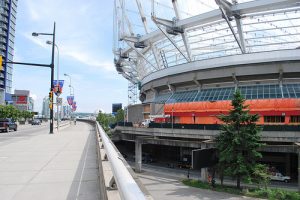Date Posted: October 12, 2011
Print Edition: October 5, 2011
 Last Friday, September 30, the newly renovated BC Place opened its doors to more than 40,000 fans. The officials in charge of the project have proclaimed that they’re “on time and on budget”, but that isn’t exactly true. According to the stadium’s website, the original budget for the project was $458 million dollars. The final cost of the project, however, was $563 million. That’s at least a $105 million difference—a difference to be made up by tax-payers. So what did that cash buy us? Here’s some of the aspects mentioned in the press release.
Last Friday, September 30, the newly renovated BC Place opened its doors to more than 40,000 fans. The officials in charge of the project have proclaimed that they’re “on time and on budget”, but that isn’t exactly true. According to the stadium’s website, the original budget for the project was $458 million dollars. The final cost of the project, however, was $563 million. That’s at least a $105 million difference—a difference to be made up by tax-payers. So what did that cash buy us? Here’s some of the aspects mentioned in the press release.
First, the doors that opened on Friday night aren’t of the rotating variety. The rotating doors BC Place used to have were nightmares necessitated by the inflatable roof, and they proved especially difficult for the disabled and the elderly. No, now they are large and open, with enough room for even the largest of linebackers to get through.
The seats are bigger, too: 5.6 inches bigger than the old blue seats, and now fitted with cup holders (very important for holding those $10.50 beers). The stadium is now walled with clear glass, as well – this replaces the previous brown glass.
Another aspect of the renovations is the new four-sided HD video board. The sideline screens are now the second largest in professional sports, behind only those of the Dallas Cowboys. There’s no shame in that – everything’s bigger in Texas, after all. The screens are 62 feet by 38 feet – approximately the size of 16 police cars, side-by-side. The screens facing the end zones are 32 feet by 21 feet – only about four and a half police cars, but still pretty big. All in all, the renovations made to BC Place stretched much further than the roof.
The roof itself was the focus of the renovation, though. When open, it reveals 100 by 85 metres of open sky – this matches the size of the stadium field. It takes just under 20 minutes to open or close, but even if a little rain does fall into the stadium, precautions have been taken to ensure safety. The flooring throughout the building is slip-resistant, there is permanent roof over the seating area, and the turf has been redesigned to allow for drainage.
The renovations are meant to pay off in the long run. The new roof will shave 25 per cent off the energy costs for the stadium, because the large fans that held up the previous roof are no longer necessary. Also, the new open-air venue in the heart of downtown is meant to attract concerts with big headliners. The increased event count at the stadium is one thing that will contribute to the estimated 3,500 new jobs that will be created by the new stadium.
Despite the successful reopening (because even if it wasn’t on budget, it was on time), there is still criticism from the public. This criticism is focused on those 3,500 new jobs: as one commenter on an article in the Vancouver Sun said, “where are those jobs going to come from? New jobs there mean lost jobs somewhere else.” The theory behind this idea is that at least some of the public customer base will be redirected from other venues: if a concert occurs at BC Place instead of Rogers Arena, that just means that less people need to be employed at the former GM Place.
Another controversy at the epicentre of criticism is the corporate sponsorship that has yet to be announced. A decision has been reached: minutes from a meeting of the Stadium’s Board of Directors says as much, though they do not name the company who won the bid. Popular opinion suggests that the stadium name will fall to either Telus or Bell. Another idea is that the stadium will be referred to as Bell Park during Whitecaps games, and Telus Centre during Lions games. The last available quote regarding the manner came from Lions CEO Dennis Skulsky in August. At that time, he said an announcement was likely to be made in mid-September. Until then, it remains – the new and improved – BC Place.


